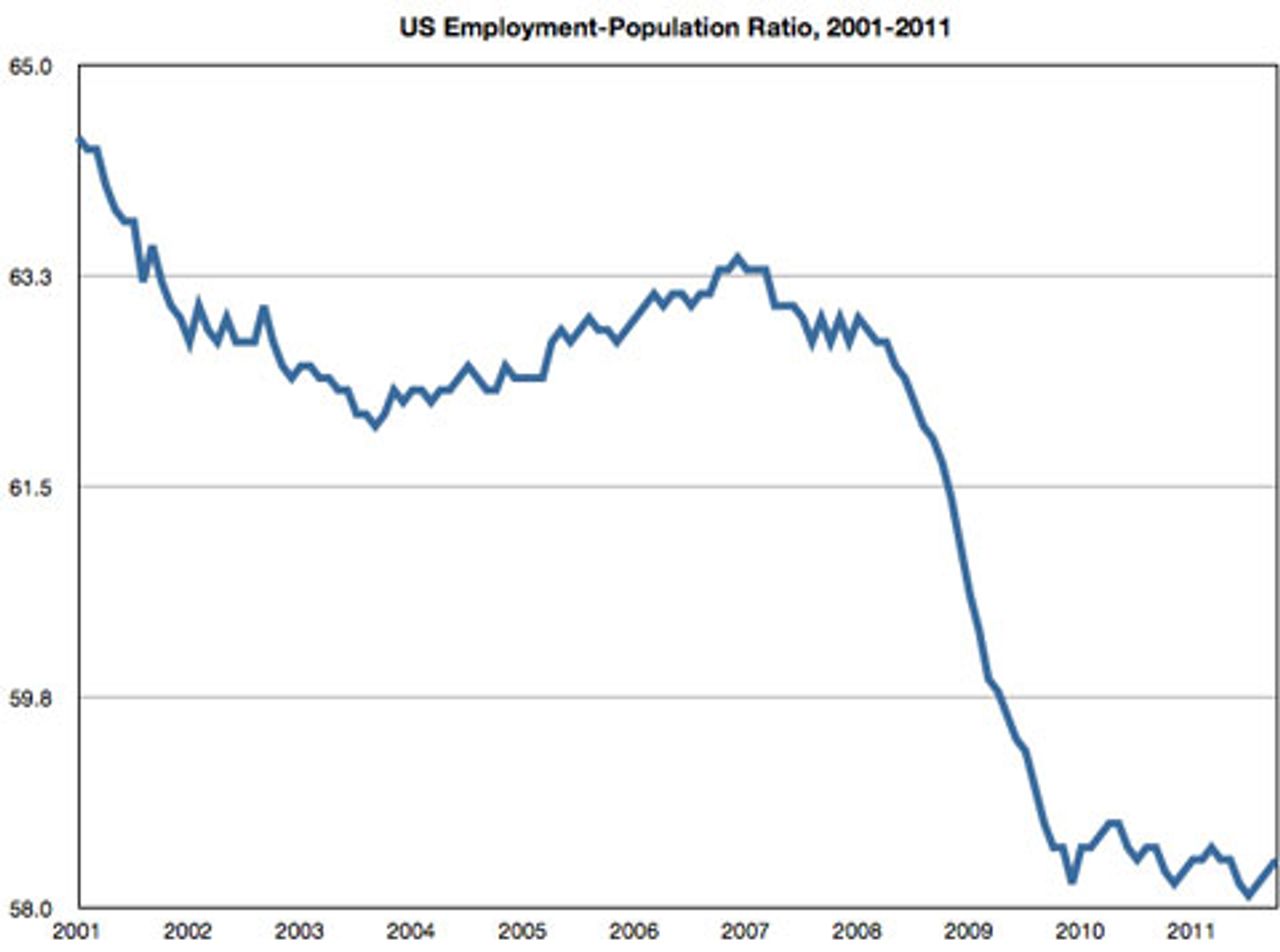Only 80,000 jobs were created in the US last month, according to the most recent report from the US Labor Department. This is far less than the number needed even to keep pace with the increase of the labor force.
 In October, anemic growth in the private sector (the addition of 104,000 jobs) was partially offset by a decline of 24,000 government jobs. Over the past 6 months, governments at all levels have cut one million jobs, the result of budget cuts in education and other social services.
In October, anemic growth in the private sector (the addition of 104,000 jobs) was partially offset by a decline of 24,000 government jobs. Over the past 6 months, governments at all levels have cut one million jobs, the result of budget cuts in education and other social services.
Most of the growth in jobs was in lower-wage service sectors, including leisure and hospitality (22,000 jobs) and professional and business services (33,000 jobs). Construction jobs fell by 20,000, while manufacturing employment increased by only 5,000.
The official unemployment rate fell from 9.1 percent to 9 percent. However, this number does not begin to capture the actual state of the jobs crisis in the US. The slow decline of the unemployment rate over the past two years is due almost entirely to the departure of hundreds of thousands of workers from the labor force.
Warning that the new report points to years of "disastrously high unemployment," the Economic Policy Institute noted, "Over the past two years, the labor force participation rate dropped from 65.1 percent (in October 2009) to 64.2 percent. That decline represents around 2.3 million workers. If those workers had remained in the labor force and been counted as unemployed, the unemployment rate today would be 10.4 percent instead of 9.0 percent."
Nearly 14 million people are officially unemployed in the United States, and there are more than 6 million fewer jobs today than before the beginning of the crisis. At the current rate, it would take more than a decade to make up for these lost jobs, not accounting for the growth of the labor force.
The broader measure of unemployment—including "marginally attached workers" (those who want work but have not actively sought it in the past month) and those who are working part-time but want full-time work—stands at 16.2 percent, down from 16.5 percent the month before. Some 26 million people in the US are unemployed, underemployed or have stopped looking for work.
A better measure of the jobs crisis than the official unemployment rate is the employment-population ratio, that is, the percentage of the overall population with a job. This figure increased by only 0.1 percentage points in October, to 58.4 percent, but remains very close to the low of 58.1 percent reached in July.
The average length of unemployment, 39.4 weeks, also remains near a historic high set in September.
Meanwhile, wages for those who are working continue to stagnate. Average hourly earnings increased by only 0.2 percent in October. Over the past year, average earnings have increased by 1.8 percent, which is not enough to keep pace with inflation. Even these figures, however, mask the sharp divergence in the fortunes of the wealthy relative to the rest of the population.
The jobs crisis for young people is particularly severe. The unemployment rate for teenagers stands at 24.1 percent. According to a recent poll conducted on behalf of Generation Opportunity, 43 percent of young people aged 18-29 are not satisfied with their current level of employment.
The ongoing jobs crisis in the United States takes place amidst signs of a renewed economic downturn on a global scale. An index of manufacturing and service output in Europe released on Friday fell to 46.5 in October, from 49.1 in September. A figure below 50 is taken to indicate contraction.
A similar index for manufacturing in China fell to 50.4 in October, its lowest level in three years and significantly below expectations.
The European economy remains mired in a protracted debt crisis, accompanied by demands for severe austerity that are already producing a sharp economic downturn. The impact on jobs will be global.
As for the United States, the Federal Reserve has reduced its forecast for economic growth in 2012 to between 2.5 percent and 2.9 percent, a full percentage point lower than predicted in June. For all of 2011, the economy is expected to grow only 1.6 percent to 1.7 percent. Unemployment is expected to remain above 8.5 percent for all of 2012. This is in fact a rosy prognosis.
In this context, the political establishment is moving decisively toward austerity. The Obama administration has put forward a series of phony "jobs" proposals that will do nothing to address the crisis, the latest being a measure that would offer tax breaks to corporations for hiring veterans from the wars in Iraq and Afghanistan.
A number of other measures, including increased infrastructure spending, have been blocked in the Senate, as was anticipated by the Democrats in advance. On Friday, the Democrats also abandoned their demagogic proposal for a "millionaire's tax" to pay for these proposals.
The real focus of both parties is to find a way to cut trillions of dollars from the federal deficit, mainly from cuts in health and retirement programs. The bipartisan deficit "supercommittee" set up in August is due to release its budget-cutting proposals later this month, and members of both parties are pushing for a deal that would include $4 trillion in deficit reduction.
